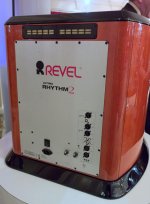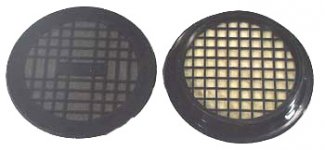It is very difficult to make a porous surface airtight. Treating a paper cone with adhesive is unlikely to do the job. What we are discussing are speakers with non-paper cones, made of inherently impermeable stuff like Mylar. Sure, for larger drivers the surround will be made of a different material, and that is likely to be porous, but for smaller drivers that is not always the case. If you take a look inside a decent pair of headphones you'll see that the Mylar 'cone' is itself formed in such a way that it doubles as the surround.What speaker, prey tell, is completely sealed between the front of the cone and the back side of the basket?
I bought one of these to make a pneumatic driver - basically I want a 6" syringe with an attached voice coil. Should be easy; they claim a solid, strong dust cap and the cone appears to be solid, thick piece of plastic. I put a shallow solid plastic cap over it to constrain the output to a 1/4" hose barb.
Leaks, leaks, leaks and leaks some more. I noticed the surround is sewn to the cone, so I covered that with GOOP cement, still leaks. I covered the dust cap, still leaks. Getting really frustrated, I painted the entire foam surround with this GOOP adhesive, made sure all the mounting holes were plugged, then glued the cap directly to the basket after removing the rubber gasket completely...
...Still leaks. I dont know what kind of drivers y'all are worried about not equalizing pressure in hours of time due to a barometric change, but I cant seem to make a given driver be airtight between front and back, no matter what I try.
I'm pretty sure the surround is porous. It's still porous after my glue treatment. Cant think of any possible path for the air pressure to get past that dustcap, cone and surround - but there is. Easily discernible just blowing into the hose barb with my mouth; better than before I went nuts with the GOOP, but nowhere near airtight.
Regarding your GOOP experiment, try blowing smoke and checking for leaks that way. Also, check the seal between the front of the basket and the enclosure - the cushion is often made of foam rubber that could well be porous.
I agree with you that normal drivers and conventional enclosures are not likely to have this issue, but this is a DIY forum - we are prone to do weird things, and it is good to think outside the box (pardon the bad pun) and be alert for unexpected pitfalls. Personally, I'm more interested in smaller drivers (I'm only in the subwoofer section because this is where Hornresp lives) and am looking at 3D printed enclosures, and these are not hypothetical concerns in that space.
Last edited:
...Still leaks. I dont know what kind of drivers y'all are worried about not equalizing pressure in hours of time due to a barometric change, but I cant seem to make a given driver be airtight between front and back, no matter what I try.
I've gotta agree, Joe. The best seal I've gotten with normal materials would nearly hold it's position when the cone was pressed in, returning to center in 2-3 seconds.
A perfect seal is one thing, but a "barely there leak" has got to be negative far SQ....
... so in other words....depending on bass activity and just frequency in general the woofer may offset the pressure inside the cabinet due to the fact that internal pressure takes 2-3 seconds to return to normal... so as long as the music is playing, internal pressure has an extra variable attached to the variant pressure experienced at a 3 second exchange rate...meaning that at 3 seconds of play back the woofer might change in internal pressure potential....and then after a quiet passage longer than 3 seconds internal pressure potential would be somewhere else....and that is a simple way to describe what will happen in a sophisticated way. I am glad that my woofers are vented in a serious way around the phase plug...so if I create a perfect seal on the inside it will just increase air exchange at the voice coil.nearly hold it's position when the cone was pressed in, returning to center in 2-3 seconds.
If the cone returns to the normal position within 2 seconds, that is approximately 0.125 Hz. No sub goes down that low. So a leak of that magnitude is completely irrelevant to the acoustic performance of the woofer.
This is also why people have been suggesting drilling a small hole in the enclosure, as a 1mm hole will have negligible impact on the low frequency response of the system.
This is also why people have been suggesting drilling a small hole in the enclosure, as a 1mm hole will have negligible impact on the low frequency response of the system.
I don't think you are correct in this assertion since a complete sine wave consists of a front to rear and back to rest cycle, like a heart beat. So barometric changes affect that whole sequence of events simultaneously.A perfect seal is one thing, but a "barely there leak" has got to be negative far SQ....
... so in other words....depending on bass activity and just frequency in general the woofer may offset the pressure inside the cabinet due to the fact that internal pressure takes 2-3 seconds to return to normal... so as long as the music is playing, internal pressure has an extra variable attached to the variant pressure experienced at a 3 second exchange rate...meaning that at 3 seconds of play back the woofer might change in internal pressure potential....and then after a quiet passage longer than 3 seconds internal pressure potential would be somewhere else....and that is a simple way to describe what will happen in a sophisticated way. I am glad that my woofers are vented in a serious way around the phase plug...so if I create a perfect seal on the inside it will just increase air exchange at the voice coil.
I find it hard to believe that such a hermetically sealed speaker box is possible. Over time, air pressure will be the same both inside and outside the box, unless a hermetic seal was possible.
It doesn't matter that the seal isn't perfect. What matters is that internal pressure equalizes potentially faster than barometric changes. For example encased tweeters with mylar domes. Some compression drivers could possibly be affected this way also.
I hadn’t ever run in to issue with sealed enclosures being “sealed” enough to show cone offsets from slowly changing barometric pressure. But, I have experienced similar issue due to rapid heat build-up in subwoofer enclosures, particularly in car audio. Adding the recommended “small” leak without generating an annoying whistle is easier said than done. I found a slightly larger hole stuffed tightly with dense foam did the trick.
You may be interested to see that this issue was addressed by Revel in at least one of their subwoofers, and Harman decided it was worth patenting.
You may be interested to see that this issue was addressed by Revel in at least one of their subwoofers, and Harman decided it was worth patenting.
Attachments
Wow. I think I'll consider reinventing the wheel! Well maybe just sliced bread🙄I hadn’t ever run in to issue with sealed enclosures being “sealed” enough to show cone offsets from slowly changing barometric pressure. But, I have experienced similar issue due to rapid heat build-up in subwoofer enclosures, particularly in car audio. Adding the recommended “small” leak without generating an annoying whistle is easier said than done. I found a slightly larger hole stuffed tightly with dense foam did the trick.
You may be interested to see that this issue was addressed by Revel in at least one of their subwoofers, and Harman decided it was worth patenting.
" The box is completely sealed except for a small pin hole (<1 mm diameter) to equalize internal with external static pressure and to prevent displacing the cone from its normal resting position."
I would have thought the hole would have caused more problems than pressure differential. I purchased a sub with a faint rattle. The noise was caused by a tiny hole where an LED had fallen out.
Last edited:
- Home
- Loudspeakers
- Subwoofers
- Equalize atmospheric pressure in sealed cabinets

